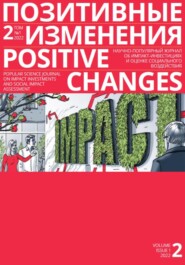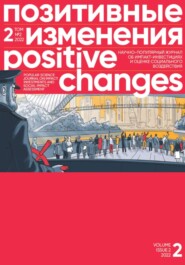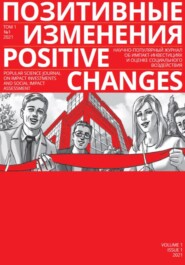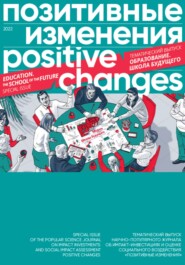По всем вопросам обращайтесь на: info@litportal.ru
(©) 2003-2025.
✖
Позитивные изменения. Города будущего. Тематический выпуск, 2022 / Positive changes. The cities of the future. Special issue, 2022
Настройки чтения
Размер шрифта
Высота строк
Поля
In this respect, the most suitable module seems to be that of the creation of "Cities of the Future." Cities of the Future are obviously the one module with most complete attributes of human life and society of the future, being essentially a scale model of the society, so all the necessary aspects and spheres of the new life model can be elaborated in the process of creating Cities of the Future.
To achieve this goal, an important element of prioritizing specifically the module of creating Cities of the Future is its multitasking – the ability to raise and solve simultaneously a great number of systemic issues necessary to build a new public system, without facing the significant risks of full-scale development of such a system, as any specific aspect and the entire system can be declared as experimental, until we are confident enough in the status of that aspect or the system in general.
Also, the Cities of the Future module can be used to address one of the most important objectives for Russia – that is, gluing together all its territories and turning them into a single effective and well-orchestrated organism. It seems necessary to address this task by defining various development concepts for different parts of Russia – Okrugs or Regions, each of which would have to perform its own unique function aligned with the predominant strengths, determinations and qualities of the respective territory and its population. At the same time, the development concept of each region must be fully aligned and integrated with the overall development concept of the country as a carrier of the new model of society’s life order – the Humane Society, revealing its various facets. This approach will enable turning the country into a single living organism, where each part is an organ performing its own function, rather than all doing the same thing, interfering and competing with each other and thus undermining each part’s capacity and ruining the synergies. It is therefore possible to develop each region into a unique competency center and the respective center of gravity for the people of appropriate nature, aptitudes, abilities and talents for certain areas of life coming from all over the country and beyond. These competency centers and centers of gravity can emerge in such sectors as education, science, culture, energy, security, economy, management, technology, production of certain goods, agriculture, various intellectual spheres, etc. It is important to emphasize here that we are not talking about the division of functions and their isolated performance by one or another part of the country; each region would still have all the institutions necessary for a fully independent functioning, with a focus on the development of a specific aspect.
An important element of prioritizing specifically the module of creating Cities of the Future is its multitasking – the ability to raise and solve simultaneously a great number of systemic issues necessary to build a new public system.
By implementing such a mechanism, we could "turn back the tide" of the current wrongheaded urbanization process, when the country’s population gravitates towards maybe fifteen to twenty cities, and ultimately to just one or two metropolitan regions, leading obviously to numerous risks and challenges.
The City of the Future, as a model, could be a territory where the people can live a full life, in and of themselves. It can be divided into residential areas, natural areas needed to maintain the environment of the common space, land for agricultural production, industrial areas, public recreation and leisure facilities (parks, squares, embankments, etc.), commercial areas (offices, business centers, etc.), consolidated trade zones, all necessary local and general social infrastructure to ensure the complete cycle of society functioning in all aspects of life – pre-school, secondary and higher education institutions, research centers, cultural amenities (theaters, cinemas, musical schools, concert halls, museums, etc.), and healthcare facilities (clinics, hospitals, medical institutes, etc.), and so on. Zoning of the City of the Future must be carried out in accordance with the new norms to ensure its integrity and self-sufficiency in performing its internal and external functions according to the principle of "autonomous organism."
It is possible to develop each region into a unique competency center and the respective center of gravity for the people of appropriate nature, aptitudes, abilities and talents for certain areas of life coming from all over the country and beyond.
Some of the following principles can be integrated in the design of the Cities of the Future:
• Population – up to about 100 thousand people;
• Total area – up to 25 km2 (for example, 5x5 km);
• Land distribution and urban zoning must follow the established norms in proportion to the total land area, to avoid disproportions and misalignment: natural territories – at least (%), public rest and recreation areas – at least (%), urban commercial and trading areas – no more than (%), residential areas with complete internal infrastructure – (%), etc.;
• Requirements for the availability of local infrastructure must be established in proportion to the capacity and purpose of the residential areas, including new types of infrastructure (neighborhood centers, community centers, urban public spaces, art spaces, co-working areas, etc.);
• As far as the local transportation is concerned, the City of the Future must prioritize the use of small and eco-friendly transport – bicycles, electric vehicles, etc.;
• Convenient and compact – the standards must establish that each urban planning unit (block, neighborhood) is to be supplied with everything necessary for the most convenient use of facilities by city residents, minimizing the need to travel around the city (to other urban planning units) and maximizing the efficient use of time;
• Eco-friendly – the cross-cutting principle of using the most environmentally friendly technologies in design, construction and operation in all areas of activity;
• Other principles.
It is particularly important to develop the infrastructure representing each sphere of life in the Cities of the Future (security, environment, provision of basic resources and needs, business, economy, finance, trade, lifestyle, fashion, management, education, culture, science, religion, worldview, etc.), each becoming a model of the development of the respective sphere in the future life order. These facilities will act as the drivers of reforms and transition towards the new life model, both for their specific spheres and the society as a whole.
Addressing the issue of building these representative facilities will require engaging the country’s leading development institutions in the corresponding areas in the joint design process, each being responsible for their own aspects in the life order of the future.
When developing new models for the organization of various spheres of life in the future and the new life order for the society of the future, all the development must be based on a single denominator, the fundamental idea of good and its manifestation, deployed and applied through various channels in each sphere.
At present, the Association of Volunteer Centers of Russia has created and operates the federal «Dobro» ("Good") Platform. The Platform has developed rapidly and widely since its launch; its underlying model of social interaction between the people based on mutual help, mutual assistance, and mutual kindness has proven relevant and viable and has received a vocal response from the majority of the country’s population who had the opportunity to experience it. This once again confirms the basic genotype of the Russian person, which is not limited to any specific national, territorial, etc. attributes but represents a universal foundation of traditional values and a certain natural moral choice of being above all a human.
We consider it reasonable to implement the Cities of the Future project largely on the basis of the Dobro Platform and the respective Association of Volunteer Centers, since this endeavor must be focused around ideology and common sense, and this will be the most adequate entry point into the project, setting it up for proper public presentation and the involvement of key development institutions and the state. The worldview vector of this Platform, although it may require some refinement and broader deployment, generally corresponds with the general future ideological vector of Russia and is aligned with the scope of the Cities of the Future project to be carried out under Russia’s flag.
Another issue of fundamental importance for joint development of the different aspects of the future life order is the consolidating ideological function of the common denominator of Good, which the namesake Platform ("Dobro" means "Good" in Russian) can be responsible for.
Since the concept of the Cities of the Future is based on the overarching idea of good and the «Dobro» Platform is already in operation, we suggest the following name for the project: Cities of the Future – "Dobro.City."
Of course, the overview in this article is somewhat simplistic, and the model of the Cities of the Future needs to be elaborated in more detail, which will be done in the process of working on this large-scale project.
Экспертные мнения / Expert Opinions
Сто лет тому вперед: архитекторы – о будущем городов
Мы не знаем, что ждет нас впереди, но верим в лучшее будущее.
Заглянуть вдаль в поиске ответов на вопрос «В каких условиях будет жить человечество?» могут прежде всего те, кто уже сейчас активно внедряют инновационные архитектурные решения. Редакция журнала «Позитивные изменения» подготовила подборку мнений руководителей и основателей известных во всем мире архитектурных бюро, чьи проекты уже сейчас меняют облик городов. Архитекторы рассуждают, как совместить окружающую среду и урбанистику, сохранить ресурсы планеты и как сделать так, чтобы город подстраивался под представления об идеальном образе жизни.
Юлия Вяткина
Редактор журнала «Позитивные изменения»
Когда говорят о городах будущего, отмечают, что это будут экогорода. Что такое экогород в вашем понимании?
Балкришна Доши, индийский архитектор, основатель Vastu Shilpa Consultants, лауреат Притцкеровской премии, работал с Ле Корбюзье:
«По-настоящему экологичный город – это город, в котором меньше всего человеческой энергии и времени тратится на достижение результатов. Только тогда у людей появляется время для размышлений, для того чтобы снова стать людьми, а не роботами, в которых их превратили».
Источник цитаты: Singh-Bartlett, W. Pritzker Prize winner Balkrishna Doshi on modernism, India and dropping your ego. Retrieved from: https://www.wallpaper.com/architecture/pritzker-prize-winner-balkrishna-doshi. 07 March 2018. Wallpaper. (accessed 08.11.2022).
В чем заключается концепция «неэкстрактивной архитектуры»? Возможно ли бережное отношение к природе в архитектуре?
Джозеф Грима, сооснователь итальянской студии дизайна Space Caviar и архитектор, куратор в Академии дизайна Эйндховена и художественный критик:
«Если человечество хочет пережить текущий эволюционный кризис, архитектура будущего должна отдавать приоритет сохранению ресурсов нашей планеты. Для этого недостаточно просто становиться лучше и лучше. С нашим постоянно растущим уровнем технологического развития мы больше не имеем права просто задумываться, сколько возможно извлечь из нашей среды обитания; мы должны спросить себя, сколько разумно извлечь <…> Неэкстрактивная архитектура должна учитывать не только текущую стоимость для человека и общества, но и цену для будущих поколений, которым придется жить с последствиями решений, принятых сегодня, на нынешнем уровне технологического развития».
Источник цитаты: Grima, J. (2021). Joseph Grima calls for «new form of architectural practice that considers the full chain of building's consequences.» Retrieved from: https://www.dezeen.com/2021/11/17/joseph-grima-manifesto-dezeen-15/. 17 November 2021. Dezeen. (accessed 08.11.2022).
Решив экологические проблемы, мы получим здоровый город?
Ма Яньсун, основатель самого известного архитектурного бюро Китая MAD Architects, профессор Пекинского университета гражданского строительства и архитектуры:
«Современные города слишком сильно завязаны на эффективность и власть капитала. Все разговоры – об экологии, загрязнении окружающей среды и дорожном движении. Все сталкиваются с этими проблемами, но это не значит, что, решив их, вы автоматически получите «здоровый город». Вы и я физически здоровы, но здоровье тела еще не означает здоровье духа. <…> Мы говорим об экологии, энергосбережении и устойчивом развитии, но, на мой взгляд, все снова сводится к технологиям. Можно установить более эффективные кондиционеры, стеклопакеты, солнечные панели – но это же не значит, что те, кто работают в этом здании, захотят остаться в нем навсегда! Они по-прежнему каждые выходные будут забывать о работе и уезжать в деревню, чтобы вновь почувствовать единение с природой. Это основа, фундаментальная причина, по которой мы сейчас начинаем говорить о природе. Если мы хотим быть ближе к природе, почему бы не понизить или не повысить температуру в комнате или в офисе на пару градусов?»
Источник цитаты: Rizzardi, P. & Hankun, Z. (TCA Think Tank). An Interview with MAD Architects' Ma Yansong: Constructing Icons, Identity & China's Future Cities. Retrieved from: https://www.archdaily.com/490712/an-interview-with-mad-architects-ma-yansong-constructing-icons-identity-and-china-s-future-cities. 03 April 2014. ArchDaily. (accessed 08.11.2022).
Можно ли обеспечить экологическую устойчивость, не жертвуя при этом уровнем жизни?
Бьярке Ингельс, датский архитектор, основатель и креативный партнер Bjarke Ingels Group:
«Вне всякого сомнения, сегодня человечество имеет возможность влиять на окружающую среду в масштабе всей планеты. Но такая огромная сила подразумевает огромную ответственность. <…> Поэтому первостепенная задача сейчас – найти разумные способы сделать наши города более жизнеспособными. Идея гедонистической экологичности подразумевает, что можно обеспечить экологическую устойчивость, не жертвуя при этом уровнем жизни. То же самое относится и к пригодности для жизни. Разумеется, некоторые меры безопасности необходимы, но они должны способствовать развитию проекта человечества и создавать превосходные условия для жизни человека».
Источник цитаты: Chu, J. Bjarke Ingels On The Future Of Architecture. Retrieved from: https://www.fastcompany.com/3041276/bjarke-ingels-on-the-future-of-architecture. 23 January 2015. Fast Company. (accessed 08.11.2022).
Какова роль архитекторов и проектировщиков города? Что они должны учесть?
Джозеф Грима, сооснователь итальянской студии дизайна Space Caviar и архитектор, куратор в Академии дизайна Эйндховена и художественный критик:
«Проектировщикам предстоит сыграть ключевую роль в реализации возможностей среды обитания будущего. Для начала можно поискать альтернативы современной географической децентрализации производства и потребления материалов».
Источник цитаты: Grima, J. (2021). Joseph Grima calls for «new form of architectural practice that considers the full chain of building's consequences.» Retrieved from: https://www.dezeen.com/2021/11/17/joseph-grima-manifesto-dezeen-15/. 17 November 2021. Dezeen. (accessed 08.11.2022).









